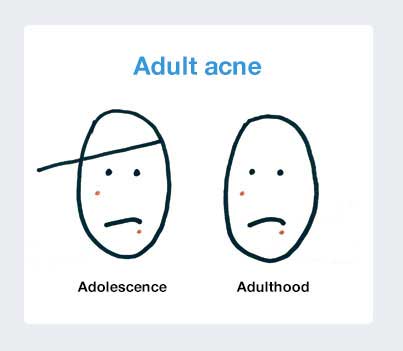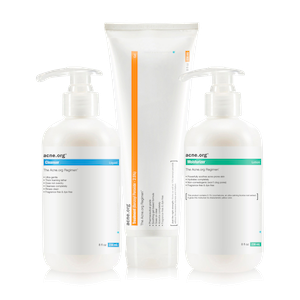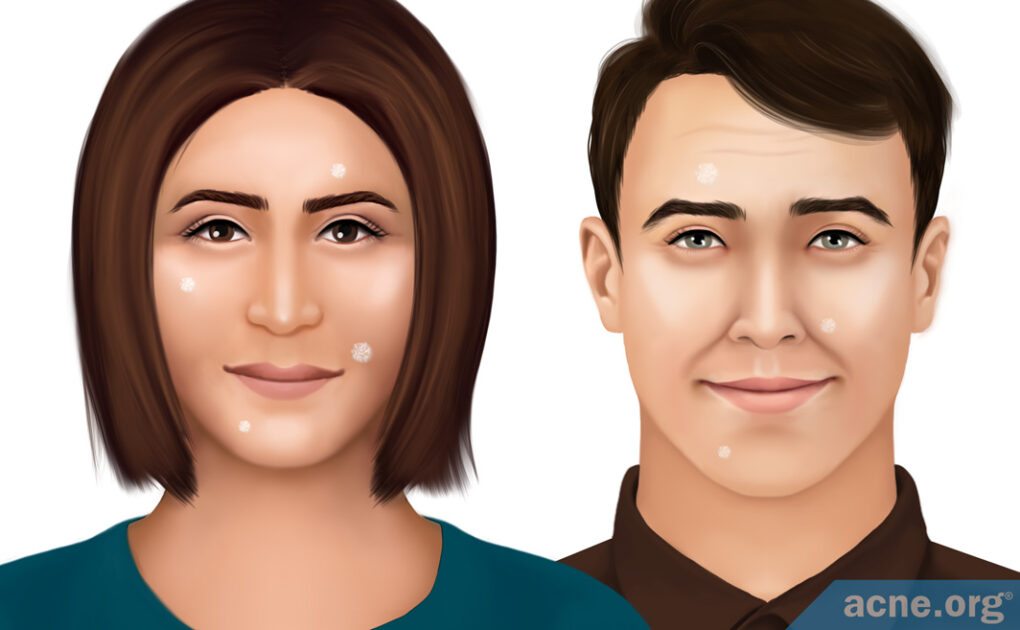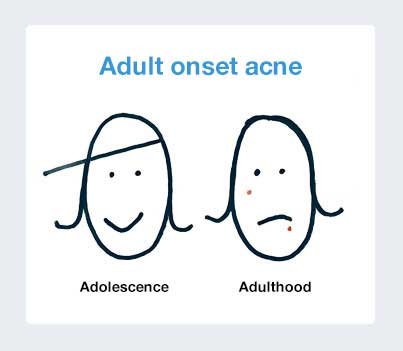The basics of acne in adult men and women

The Essential Info
Adult acne is common and tends to afflict women more than men, but can affect both genders on the face and/or body.
Usually adult acne is simply the result of adolescent acne continuing into adulthood, however, particularly in women, acne can present itself for the first time during adulthood, most likely due to fluctuating monthly hormones.
Treatment is the same for adult acne as it is for adolescent acne. But can differ slightly between men and women:
Men: Most cases of acne can be brought under complete control with a properly applied benzoyl peroxide regimen. Severe, scarring cases may need isotretinoin (Accutane), but this should never be entered into lightly.
Women: Most cases of acne can be completely cleared with a properly applied benzoyl peroxide regimen. Women also have the option of hormonal treatment, such as oral contraceptives (birth control pills), and anti-androgen medications like spironolactone. Severe, scarring cases may necessitate a conversation about isotretinoin (Accutane), but this should never be entered into lightly since it can cause lifelong side effects and is the #1 most birth defect-causing medication on the market.

The Science
…there appears to be an increase in post-adolescent acne, and that the disease is lasting longer and is requiring treatment well into the mid forties.”2
– International Journal of Cosmetic Science, 2004
Adult acne affects 25% of adult men and 50% of adult women at some time in their adult lives. 1/3 of adults affected with facial acne also have acne on their back and body. These are the official statistics, but most adults have had a zit or two in their adult lives. For still unknown reasons, people seem to be struggling with acne into their 20s, 30s, 40s and beyond.1-3Dermatologists find themselves seeing more adult acne patients than in previous decades. Adult acne can cause depression and social anxiety in an adult the same way it can in a teen.2,4
Adult acne versus adult onset acne
Primarily men:

If a man experiences acne as an adult, most likely he simply has adult acne. This means a case of acne which is stubborn and has held on since adolescence without reprieve. Few men experience adult onset acne – acne which suddenly develops well into a man’s 20s or later. If a man does experience adult onset acne, it is likely due to some sort of prolonged irritation of the skin or comedogenic product he is using.
Treatment of acne in the adult
Men
Since acne in a man is normally the same stubborn case of acne he had as a teen, treatment usually remains the same. There are two treatments which will consistently and predictably clear up most men. The first is The Regimen, which harnesses the power of benzoyl peroxide. When used precisely as outlined, The Regimen will provide for total clearing in most adult males. Accutane (isotretinoin), while it is often reserved for males with moderate to severe acne and can come with serious side effects, tends to cure about 2/3 of men who take it as well. Dermatologists can also prescribe other medications, but the majority tend to disappoint and will only clear the skin to a limited degree.
Women
Female hormones tend to fluctuate more than male hormones, and unlike men, hormonal treatment is an option for women.5-11If you are experiencing waves of premenstrual breakouts or are simply dealing with the same stubborn case of acne you had as an adolescent, a quick check of hormone levels (you can ask your family doctor for this test) is prudent. However, if you and your doctor decide not to pursue hormonal treatment, The Regimen, which harnesses the power of benzoyl peroxide, will prove strong enough to completely clear up most women. Doctors can also prescribe Accutane (isotretinoin), a powerful systemic oral medication, to women with more severe acne. Accutane provides a cure to about 2/3 of women, but comes with severe side effects including severe birth defects. Doctors can also prescribe other medications, but research shows that the majority of these prescriptions only clear the skin to a limited degree.
A special case: Poly-Cystic Ovary Syndrome: If you experience a stubborn outbreak of adult onset acne, especially if it comes with hirsuitism (hair overgrowth) and/or menstrual irregularities, it may be a good idea to speak to your doctor to rule out the possibility of poly-cystic ovary syndrome, a disorder that can affect hormone levels and result in acne.12
References
- Cunliffe, W. J., Goulden, V. & Stables, G. I. Prevalence of Facial Acne in Adults. J. Am. Acad. Dermatol. 41, 577-580 (1999). https://www.ncbi.nlm.nih.gov/pubmed/10495379
- Knaggs, H. E. et al. Post-adolescent acne. Int. J. Cosmet. Sci. 26, 129-138 (2004). https://onlinelibrary.wiley.com/doi/abs/10.1111/j.1467-2494.2004.00210.x
- Collier, C. N. et al. The prevalence of acne in adults 20 years and older. J. Am. Acad. Dermatol. 58, 56-59 (2008). https://www.ncbi.nlm.nih.gov/pubmed/17945383
- Gollnick, H. P. M., Finlay, A. Y. & Shear, N. Can we define acne as a chronic disease? If so, how and when? Am. J. Clin. Dermatol. 9, 279-284 (2008). https://www.ncbi.nlm.nih.gov/pubmed/18717602
- George, R., Clarke, S. & Thiboutot, D. Hormonal therapy for acne. Semin. Cutan. Med. Surg. 27, 188-196 (2008). https://www.ncbi.nlm.nih.gov/pubmed/18786497
- Seirafi, H. et al. Assessment of androgens in women with adult-onset acne. Int. J. Dermatol. 46, 1188-1191 (2007). https://www.ncbi.nlm.nih.gov/pubmed/17988341
- Williams, C. & Layton, A. M. Persistent acne in women: implications for the patient and for therapy. Am. J. Clin. Dermatol. 7, 281-290 (2006). https://www.ncbi.nlm.nih.gov/pubmed/17007539
- Bataille, V., Snieder, H., MacGregor, A. J., Sasieni, P. and Spector, T. D. The influence of genetics and environmental factors in the pathogenesis of acne: a twin study of acne in women. J. Invest. Dermatol. 119, 1317-1322 (2002). https://www.ncbi.nlm.nih.gov/pubmed/12485434
- Cunliffe, W. J., Goulden, V. & McGeown, C. H. The Familial Risk of Adult Acne: A Comparison Between First-Degree Relatives of Affected and Unaffected Individuals. Br. J. Dermatol. 141, 297-300 (1999). https://www.ncbi.nlm.nih.gov/pubmed/10468803
- Ascenso, A. & Marques, H. C. Acne in the adult. Mini Rev. Med. Chem. 9, 1-10 (2009). https://www.ncbi.nlm.nih.gov/pubmed/19149656
- Choi, C. W. et al. The clinical features of late onsent acne compared with early onset acne in women. J. Eur. Acad. Dermatol. Venereol. 25, 454-461 (2010). https://www.ncbi.nlm.nih.gov/pubmed/20659307
- Kamangar, F. & Shinkai, K. Acne in the adult female patient: a practical approach. Int. J. Dermatol. 51, 1162-1174 (2012). https://www.ncbi.nlm.nih.gov/pubmed/22994662
 Acne.org Products
Acne.org Products
